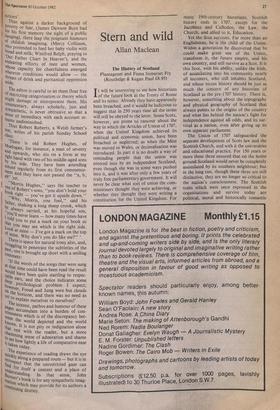Stern and wild
Allan Maclean
The History of Scotland Plantagenet and Fiona Somerset Fry (Routledge & Kegan Paul £8.95) It will be interesting to see how historians
of the future look at the Treaty of Rome and its terms. Already they have apparently been breached, and it would be ludicrous to suggest that in 250 years time all the terms will still be obeyed to the letter. Some Scots, however, are prone to rancour about the way in which the Articles of Union of 1707, when the United Kingdom achieved its political and economic union, have been breached or neglected; as when the Mint was moved to Wales, or decimalisation was introduced. In part it is no doubt a way of reminding people that the union was entered into by an independent Scotland, even though she was in some ways pushed into it, and it was after only a few years of truly free parliamentary government. It will never be clear what sort of union the com- missioners thought they were achieving, or whether they thought they were writing a constitution for the United Kingdom. For
many 19th-century historians, Scottish history ends in 1707, except for the Jacobites and Culloden, the Law, the Church, and allied to it, Education.
Yet the Scot survives. Far more than an Englishman, he is the child of the Union. Within a generation he discovered that he could make great use of the Union, transform it, the future empire, and his own country, and still survive as a Scot, It is this Scot, with his ability, unlike the Irish, of assimilating into his community nearly all incomers, who still inhabits Scotland, and whose recent history should be just as much the concern of any historian of Scotland as the pre-1707 history. There is, however, something about the topography and physical geography of Scotland that always points to the origins of the country and what lies behind the nation's fight for independence against all odds, and its sur- vival as a nation, even after giving up its own separate parliament.
The Union of 1707 safeguarded the separate development of Scots law and the Scottish Church, and with it the universities and educational practice. For 150 years or more these three ensured that on the home ground Scotland would never be completely assimilated by its southern neighbour; but in the long run, though these three are still distinctive, they are no longer so critical to the nation's consciousness. The Scottish traits which were once expressed in the organisations and survive today are political, moral and historically romantic characteristics. Politically the working Scot has been an activist, be it in the democratic institutions of the presbyterian church, or the founding of the Labour party; together with a great social and ethical conscience. Romantically the Scot looks for a past golden age, aided by Ossian Macpherson and Sir Walter Scott, who made it accep- table to be a Scot, or to have a Scotch gran- ny. That historically the Scot had never quite succeeded in history is believed by most Scots to be due to their southern neighbour, whose very existence is the other major ingredient in the Scots make-up; and blamed for all ills.
Firm and erect the Caledonian stood, Old was his mutton, and his claret good. 'Let him drink port!' the Saxon statesman cried.
He drank the poison, and his spirit died.
(John Home)
I was reminded of these elements in the Scots character by The History of Scotland — an arrogant title which has hardly been used since Sir Walter Scott's similarly nam- ed book, written to complement Sir James Mackintosh's abridgement of English history. This new one is yet another attempt at writing Scottish history, (for school use?), intended for the southern neighbour, and it repeats (with many new mistakes) the old theories that Scottish history virtually ended in 1707, making great play on the na- tion 'losing its independence'; with its na- tional history finally concluded at Culloden Field (where there were, after all, more Scots in the royal army than in the Jacobite army) which was itself closely allied to the Clearances.
Scottish history survives since then, for the authors, only in those things which are landmarks for Scotland, and do not come from what the authors term the 'take-over' nation (though it was a Scots king who became King of England). They see this sur- vival largely in the usual institutions of the ,Law, the Church (but only as Presbyter- ianism, where, incidentally, a moderate is called 'fiery'), Education (where a whole university at Aberdeen is forgotten) and, in- evitably, in the Scottish National Party (`the movement has not declined' since 1979). Everything since 1690, including the Union, fits into two chapters out of 13. Up to 1707 it is a history of the politics of kings and courtiers (who are virtually all depicted as villains) rather than a social and economic history, but thereafter what history is in- cluded is only the latter. George IV's visit is forgotten, and Queen Victoria is never mentioned.
The theme is that Scotland has now been reborn, and the challenge is for Scots to take charge of their own business affairs, to produce their own leaders, statesmen and financiers, devoted to Scottish interests. One wonders quite who has been ruling Scotland in the last 250 years.
The dust-jacket of this attempt at a non- romantic history appeals to all that is romantic, for it depicts a Scottish castle with the sun setting over the Western Isles!











































 Previous page
Previous page